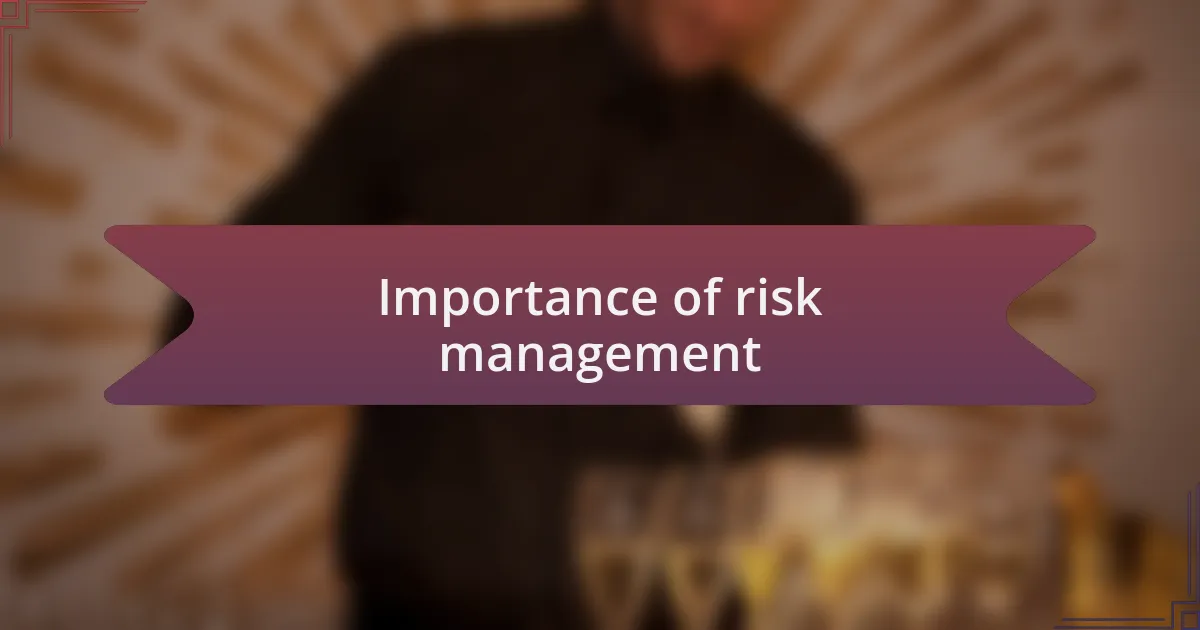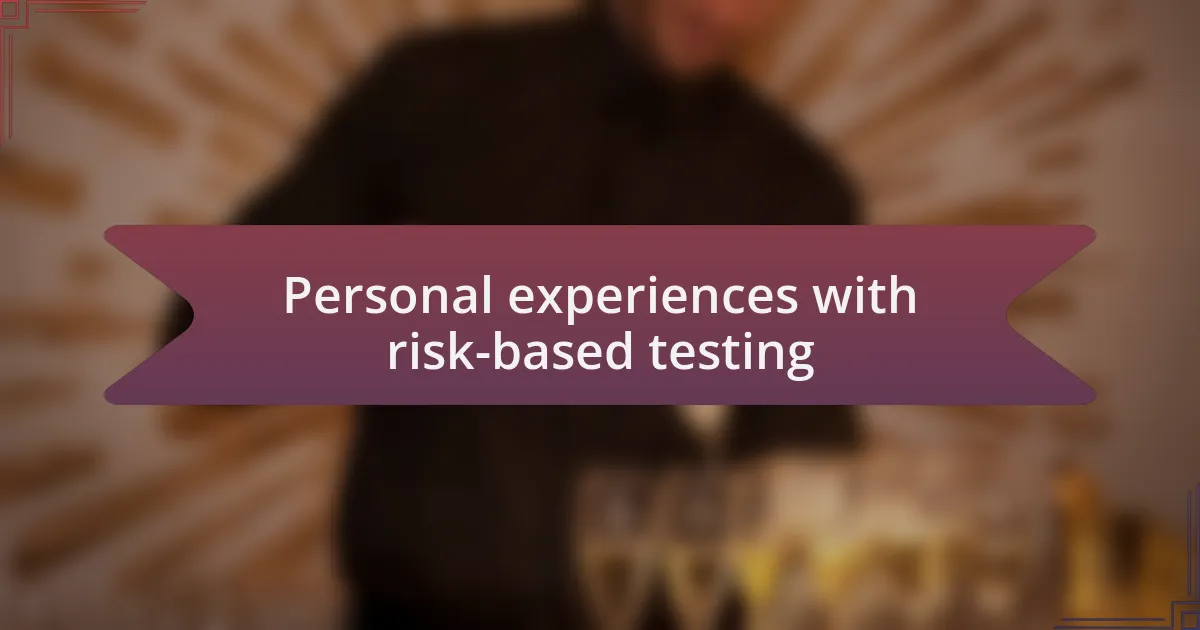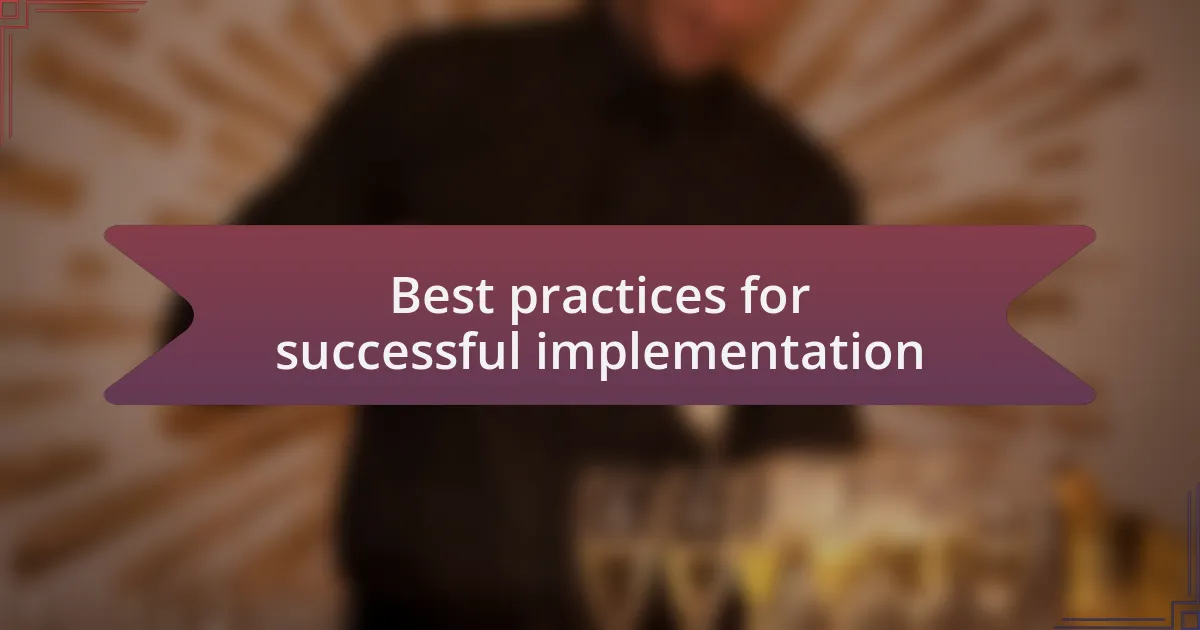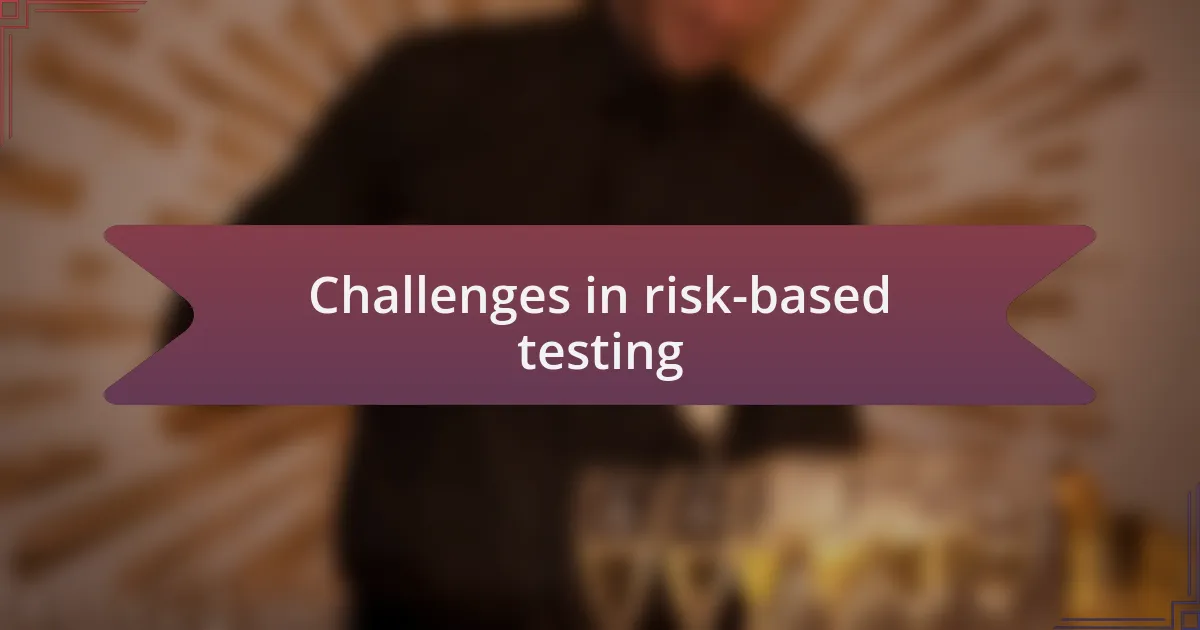Key takeaways:
- Risk-based testing prioritizes testing efforts based on the potential impact of software failures, focusing resources on the highest-risk areas.
- Effective risk management requires continuous assessment and collaboration among team members to identify and address evolving risks throughout the project lifecycle.
- Communication is crucial for successful implementation; regular discussions about risks can uncover hidden challenges and ensure that the team’s focus adapts as new risks emerge.
- Challenges include subjectivity in risk assessment, difficulty in quantifying risks, and issues with resource allocation, necessitating a strategic approach to decision-making.

Understanding risk-based testing
Risk-based testing is essentially about prioritizing testing efforts based on the potential risks associated with software failures. I remember a time when I was part of a project with tight deadlines, and we had to decide where to focus our testing. Rather than testing every feature equally, we assessed which ones had the highest impact if they failed. This approach not only saved us time but also ensured that our most critical functionalities were robust before release.
In my experience, understanding the risks involved in a project can often be the difference between success and a costly setback. Have you ever faced a situation where a small oversight led to significant issues down the line? By evaluating the likelihood of different risks and their potential fallout, you can allocate resources more effectively. It changes how you view testing—from a broad, exhaustive process to a strategic, nimble approach.
Ultimately, risk-based testing allows teams to effectively manage uncertainty within their projects. The emotional weight of looming risks can be daunting, but I’ve found that having a clear strategy helps alleviate a lot of that fear. Embracing this testing philosophy not only builds confidence in your product but also strengthens the overall development process, making it a win-win for both the team and the end-users.

Importance of risk management
Managing risk is crucial in any software development project. From my own experience, I’ve seen how adopting a proactive risk management strategy can significantly impact project outcomes. When we identify potential risks early, it allows the team to create mitigation plans that can prevent small issues from escalating into major problems. Have you ever started a project thinking everything was fine, only to find that a small oversight caused chaos later? That’s where risk management steps in, ensuring we stay one step ahead.
One memorable project taught me the value of prioritizing risks. We faced a tight timeline, and instead of trying to address every conceivable issue, we focused on risks that could lead to the most significant costs if they materialized. I vividly recall how this shift in our approach gave us peace of mind. With a clear picture of where our vulnerabilities lay, I was able to direct my team’s energy towards the high-stakes areas, ultimately making our release smoother and less stressful.
Without effective risk management, software development can feel like navigating uncharted waters. The anxiety of uncertainty can cloud decision-making and hinder creativity. Embracing risk management not only dispels this cloud but also fosters a culture where teams can innovate freely, knowing they’ve evaluated their potential pitfalls. Isn’t it empowering to walk into a project with a structured plan that acknowledges risks while also providing paths to success?

Key principles of risk-based testing
Risk-based testing revolves around a few key principles that guide its implementation. One of the most significant is prioritization. I often find that not all defects are created equal; some can cost time and resources disproportionately compared to others. In a project I worked on recently, we prioritized testing features that were crucial to user satisfaction first. This approach allowed us to focus our efforts where they would make the most impact, giving me the confidence to release a quality product without feeling overwhelmed.
Another principle that stands out to me is the continuous assessment of risk. It’s not a one-time checklist but an evolving dialogue throughout the project lifecycle. I recall a phase in a previous job when risks morphed mid-development due to changing customer requirements. By regularly re-evaluating our risk landscape, we could adapt our testing strategies swiftly, ensuring we were always aligned with the project’s most pressing needs. Have you ever revisited a plan only to find that it no longer serves its purpose? That realization drives home the importance of flexibility in risk-based testing.
Lastly, collaboration emerges as a vital principle. Engaging with different team members brings diverse perspectives to the table. I remember discussing potential risks with our developers and stakeholders; their insights often highlighted blind spots I hadn’t considered. This collaboration not only enriched our testing approach but also fostered a shared responsibility for the project’s success. Have you felt that sense of camaraderie when everyone is on the same page with a common goal? It’s a powerful motivator that can transform risks into opportunities.

How to implement risk-based testing
To implement risk-based testing effectively, start by conducting a thorough risk assessment. In my experience, gathering input from various stakeholders during this phase is crucial. I once facilitated a brainstorming session where each team member ranked potential risks based on their impact and likelihood. This collaborative effort not only unveiled hidden risks but also made everyone feel invested in the testing process. Have you ever discovered a risk you’d overlooked simply because you weren’t engaging with others?
Next, it’s essential to develop a tailored testing strategy that prioritizes high-risk areas. I remember a project where we had a tight deadline; instead of testing everything equally, we focused on components with the highest user interaction. By doing this, we were able to reveal critical defects early on, which ultimately saved time and reduced stress for the entire team. It’s amazing how targeted efforts can yield significant results, isn’t it?
Finally, keep the conversation going throughout the testing cycle. Adapting your approach as new risks arise is vital. There was a time when unexpected changes in project scope altered our risk profile significantly. I encouraged the team to hold quick daily check-ins to address these shifts immediately. This ongoing dialogue not only helped us stay on track but also cultivated a proactive mindset. Have you considered how continuous communication could enhance your testing strategy?

Personal experiences with risk-based testing
When I first encountered risk-based testing, it felt like a revelation. I distinctly remember a project where our initial testing approach was more about ticking boxes than addressing real-world concerns. After shifting to a risk-based perspective, I felt a newfound clarity—focusing on the riskiest areas opened my eyes to potential issues I hadn’t even considered. Why had I been so focused on the minutiae instead of the bigger picture?
One particular experience stands out. During a user acceptance testing phase, we discovered that a critical feature was vulnerable to a simple, yet impactful bug. Had we not prioritized our testing around the most-used features, would this oversight have made it to the live environment? This question still lingers in my mind, emphasizing how vital risk identification was for not just our team but for the end-users depending on our product.
I’ve also learned that embracing the uncertainty in risk-based testing can actually be empowering. In a project where we faced multiple technical challenges, I guided our team in viewing risks not as obstacles but as opportunities for improvement. It was a transformative moment when one team member suggested implementing an automated test for a particularly risky area. The relief we felt when that approach identified issues swiftly was palpable. Isn’t it fascinating how a shift in perspective can change the outcome entirely?

Best practices for successful implementation
The cornerstone of successful implementation in risk-based testing is communication. I often emphasize to my team the importance of discussing risks openly, as it creates a shared understanding of priorities. For example, during one project, a 15-minute team huddle allowed us to identify a previously overlooked server issue that later turned out to be a significant risk factor. Have you ever noticed how just a bit of conversation can illuminate hidden challenges?
Another best practice I’ve found is integrating risk assessments into the entire development lifecycle, not just at the beginning. I remember a time when our agile sprint reviews included a quick risk check-in. This simple act ensured the team regularly recalibrated our focus based on new insights. It made me realize that risks evolve, and so should our attention. Isn’t it crucial to adapt our testing strategy as new risks emerge rather than waiting for a testing phase?
Additionally, I believe in leveraging data to inform risk decisions. In a past project, we utilized analytics from previous releases to guide our testing efforts. This data approach not only provided clarity but also built confidence in our risk prioritization decisions. Isn’t it amazing how data can transform what feels like guesswork into informed strategy? Balancing intuition with empirical evidence definitely elevates the effectiveness of our testing efforts.

Challenges in risk-based testing
The challenges in risk-based testing can be quite profound. One of my biggest hurdles has been the subjectivity involved in risk assessment. For instance, I once encountered a project where team members had differing perspectives on what constituted a critical risk. This disagreement not only slowed down our progress but also created unnecessary tension. Have you faced a similar situation where differing opinions on risks led to confusion?
Another significant challenge is the difficulty in quantifying risks. I recall a project where we had to navigate potential security vulnerabilities. While we all understood the stakes, translating that understanding into actionable testing priorities was daunting. It made me question: how do you measure something as complex and intangible as risk? I often think that without clear metrics or frameworks, it can feel like we are shooting in the dark.
Lastly, there’s the ever-present issue of resource allocation. I once worked on a team that had limited testing time and personnel, which forced tough decisions about which risks to prioritize. It left me wondering—how do we decide where to invest our limited resources? It’s a balancing act of confidence and strategy, constantly weighing what we can afford to overlook against what might ultimately lead to project failure.